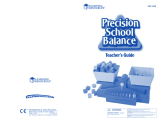Page is loading ...

LER 2049
Look for these other great
products available from
Learning Resources®:
Look for these other great
products available from
Learning Resources®:
© Learning Resources, Inc., Vernon Hills, IL (U.S.A.)
Learning Resources Ltd., King’s Lynn, Norfolk (U.K.)
Please retain our address for future reference.
Made in China. LRM2049-GUD
• LER 1323 - Ten Row Counting Abacus
• LER 1521 - Primary Bucket Balance
• LER 1323 - Ten Row Counting Abacus
• LER 1521 - Primary Bucket Balance
A unique way to
learn number values!
A unique way to
learn number values!

The Weighted Numbers set from Learning Resources% is a great
addition to any classroom. Numbering 1 through 10, each number
increases in weight by 5 grams. Therefore, if you were to add 2 + 5
it would be equal to 7 on a balance. However, there is a degree of
sensitivity and each number varies by .05 -1 gram. Weighted
Numbers can be used in a variety of different ways. The following
are a few suggestions and ideas on how to use the numbers in the
classroom including number recognition, number sentences, and
balance and scale activities.
NUMBER RECOGNITION
Great for young students learning their numbers! Odd and even numbers are color
coded for easy identification. The name of the number is also printed on one side
for self-checking.
• Explain to students that the odd and even numbers are in different
colors. Hold up the numbers one at a time and ask students to name each
number. In addition to saying the name of the number, have students state
if it is even or odd. For example, you hold up the number 5. The students
should say "5, odd."
• Place ten piles of items on a table. Each pile should contain a number of
items ranging from 1 to 10 items. For example, one pencil, two paper clips,
three erasers and so on. Place the weighted numbers in front of the piles
and ask the students to determine if the number accurately represents the
number of items in the pile. Then have the students work together until all
the correct numbers are in front of the piles with that quantity.
NUMBER SENTENCES
Learning the proper order in which numbers belong is a fundamental skill for higher
mathematics. Since the Weighted Numbers increase in weight by 5 gram incre-
ments, students can feel the difference between the numbers and determine which
number is greater.
• Ask for a volunteer to help demonstrate what numbers are greater. Show
students two numbers and ask which they think is the greater number.
For example, show a 10 and a 2. Once the class gives their answer have the
volunteer close their eyes and hold out both of their hands. Place the 10
into one hand and the 2 in the other hand. Ask them to determine, without
looking, which number is greater by feeling the difference in weight. Have
the student identify that the number in their right hand (10) is more than
the number in their left hand (2). Have the student open his eyes and show
the numbers. Was the class correct in their guess as to which number was
greater?
• Ask students to put the numbers in order from one to ten. Then ask
the students to put in order from least to greatest the even numbers
and then the odd numbers. Students may feel the Weighted Numbers to
help them place the numbers in order. Once the students determine the
orders, ask them to write the numbers and the names of the numbers in
order on a piece of paper.
BALANCE/SCALE ACTIVITIES
If there is a balance or scale available, the Weighted Numbers can be used to
demonstrate relationships between the numbers. They can also be used to help
introduce the concepts of addition and beginning algebra.
• Ask students if there are any special relationships between the even
numbers or between the odd numbers? On a balance place the number
1 and 2 on the same side. What number balances the 1 and 2? Try "adding"
the number 2 to the 3, 2 to the 5 and so on. What number balances the 3
and 2? The 5 and 2? And so on.
• Set up two numbers on each side of a scale, for example a 3 on one
side and a 10 on the other side. Ask students what number they
think will balance the scale. Have them write the equation 3 + X = 10.
Then, have the students experiment with the numbers to determine the
value of X. How did they determine the correct number was 7? What are
some ways, other than using a scale, they can find the correct number? Use
the scale and numbers to set up different equations for the students to
explore and solve.
/












